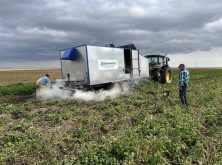Willem van Staveren says you can’t beat early weed control.
In fact, every year on the family-run southern Saskatchewan farm, the Van Staverens plan for a post-harvest herbicide application to help control winter annual and perennial weeds in preparation for the following growing season.
“It is important for us to make the late fall herbicide application particularly to control perennial weeds,” says Van Staveren.
Read Also

Cancer agency reclassifies another herbicide ‘probably carcinogenic’
The WHO’s cancer research agency has now put atrazine, a herbicide well known to corn growers, in the same potential-hazard category where the agency put glyphosate.
“If you happen to miss a year with a fall application, you really notice those weeds the next growing season. For us, that post-harvest weed control is the beginning of, or gateway, to a successful cropping season the coming year.”
Van Staveren, who is part of JVM Van Staveren Farms at Creelman, about 1.5 hours southeast of Regina, says perennials and winter annuals such as dandelions, thistle and particularly kochia are targeted in the farm’s fall weed control program.
Quite often he applies a broad spectrum herbicide, such as glyphosate, tank mixed with another herbicide with a residual mode of action. All cropped acres are covered, but depending on the fall and the weed spectrum, either the whole field is treated or is spot sprayed.
The next spring, the pre-seed weed control program depends on growing conditions, he says.
“Hopefully we can begin seeding that last week of April. If it is an early spring, we might be out a few days earlier, or if it is cold we may not get started until early May, but we aim for late April,” he says.
“As far as weed control it depends what is growing. If the ground is cold and we’re not seeing volunteer cereals or canola or those annual weeds, then we won’t spray. If the weeds are there we apply a pre-seeding herbicide application.”
Some years a pre-emergent herbicide is applied during that narrow window between seeding and crop emergence, but timing is important to avoid crop injury.
The field sprayer is a critical piece of equipment on the farm, says Van Staveren. There may be a break of a week or two after pre-seed herbicides have been applied, but then sprayers run pretty steady applying in-crop herbicides and other crop protection products right through to fall.
Early weed control advantages
Trevor Herzog, western agronomy lead with Corteva Agriscience agrees that timely weed control is the key to a successful crop.
“If farmers allow weeds to persist for even a few days, it begins to affect the yield potential of the crop,” says Herzog, who is based in Yorkton, Sask.
“Well-timed weed control early in the growing season when weeds are small is the key to optimizing yield.”
Herzog agrees that a post-harvest weed control program that targets perennials and winter annuals can be very effective in reducing weed pressure on the crop the following spring.
Fall is an effective time to control perennials, winter annuals and annuals such as narrow-leaved hawk’s beard, dandelion, kochia and thistle.
And if applied early enough, the fall treatment can often help reduce the production of weed seeds leading to fewer seeds being added to the seed bank in the soil.
“A fall-applied herbicide that includes a residual product can stop weeds before they emerge in the spring,” he says.
“That effective fall application takes the pressure off of the early spring weed control program.”
In the spring, Herzog says a well-timed pre-seed herbicide application can help the crop get off to a good start.
“A lot of times I see farmers applying that pre-seeding burnoff perhaps a few hours or within a day of seeding, allowing for as many weeds as possible to emerge,” he says. “That pre-seeding burnoff gives the crop a head start.”
In more recent years he says it is becoming common for farmers to use a broad spectrum herbicide, such as glyphosate, tank mixed with one or two other herbicides.
“Using multiple products with different modes of action help to keep the weeds guessing,” says Herzog.
“It is important for farmers to know their weed spectrum. Using multiple products can help control weeds where perhaps glyphosate is less effective. And it is also an effective management tool for controlling glyphosate-resistant weeds as well as reducing the risk of selecting weeds with herbicide resistance.”
Herzog says depending on crop rotation the pre-seed burnoff can include a tank mix with a herbicide with a residual mode of action, which helps to control weeds that haven’t emerged at time of seeding. “A residual herbicide can be an effective tool,” he says. “You just need to pay close attention to re-cropping restrictions.”
Herzog says farmers have options to use a wide range of tools or “tactics” when it comes to effective weed control. Crop rotation is important and knowing your weed spectrum, which helps farmers select the most effective herbicides. Proper timing with effective herbicides, pre- or post-harvest, pre-seed and in-crop applications, need to be considered.
“And we are starting to see other tools such as weed seed crushers that attach to the combine as a tool that helps reduce the number of weed seeds. And, of course, depending on soil and moisture conditions, tillage might also be an option for some producers,” he says.
“Everything has its pros and cons. It is important that weed control measures be applied in a timely manner, giving the crop opportunity to reach its full yield potential.”
Early weed control payoff
Research over the years has shown there is a definite economic benefit from early weed control. Studies show regardless of weed control measures, if the weeds get ahead of the crop a certain amount of yield potential cannot be recovered.
The Canola Council of Canada (CCC) has looked at a number of studies over the years that emphasize the economic benefit of early weed control. Here is how the numbers stack up.
1. Agriculture and Agri-Food Canada (AAFC) summarized nine site years of spray timings of Roundup Ready canola at Lacombe, Beaverlodge and Edmonton, Alta. Glyphosate was applied at the one- to two-leaf stages, three- to four-leaf stages and five- to six-leaf stages of the crop. In seven out of nine cases, early timings (one- to four-leaf stages) resulted in the highest canola yields of all treatments.
Similar research also led AAFC weed scientists Neil Harker and John O’Donovan to estimate the effects on yield — one weed emerging a week before the crop is equivalent to 100 weeds emerging three weeks after the crop.
2. Another AAFC canola study found weed control was more important than any other major input. A summary in Canola Digest Science Edition 2013 states: “In a barley-canola rotation, the primary input that influenced yield was weed control. Without weed control, the addition of genetics, a higher seeding rate and nitrogen fertilizer had no impact on net return.”
3. A study conducted by applied research associations in Alberta with seven farm field trials across the province found that waiting for late weeds to germinate did not pay. The results showed a 224 kilogram per hectare (four bushel per acre) yield increase by spraying weeds at the one-leaf stage versus the five-leaf stage.
4. Trials conducted by the University of Manitoba at multiple locations in the late 1990s showed it was necessary to control weeds by the four-leaf stage to prevent yield loss greater than 10 per cent.
5. In weed control timing trials by the CCC at Crop Production Centres across Western Canada also in the late 1990s, at 24 seeding date/locations out of 27, the earliest timings gave the best yields. The early applications showed a 16 per cent yield advantage compared with later timings.
Research has demonstrated a yield advantage of seven bushels per acre if weeds are controlled at the one- to two-leaf stages of canola compared with the control of weeds at the six- to seven-leaf stages.
6. University of Saskatchewan research led by Ken Sapsford and Rick Holm found, in terms of yield, early weed control is even more beneficial than early seeding — even if you won’t be seeding for a couple of weeks. While this particular study was done on wheat, Sapsford says the results would be similar for canola.
Winter annual weeds like flixweed, shepherd’s purse, narrow-leaved hawk’s beard and stinkweed can remove a lot of soil moisture in the spring as they begin to grow very early and are very inefficient water users. Early weed control stops this uptake, preserving moisture and nutrients for the crop.
Clark Brenzil, Saskatchewan’s provincial weed control specialist, said the study compared yields for three combinations: early weed control with seeding the day after, early weed control with late seeding and late weed control with late seeding.
“The first two treatments yielded similarly, whereas the burnoff done just before the later seeding date had a reduction in yield compared with the other two,” Brenzil says. His recommendation: “Your sprayer can travel a lot better on fields that aren’t suitable for seeding, so get the pre-seed burnoff done early over all of your fields and then start seeding.”
7. Analysis of a 2011 CCC grower survey reported farmers spraying at the one- to two-leaf stages had higher yields than those going in earlier or later with their first in-crop herbicide application.
8. Soybean research at the University of Guelph found that light reflected from neighbouring weeds will induce a soybean plant’s “shade avoidance response,” which leads to increased variability in yields.
In short, the soybean crop — as soon as it “sees” the weeds — will alter its growing pattern, putting less energy into roots and more energy into taller stems. Although the research hasn’t been done, it is suspected this response could apply to canola as well.
For more details visit the CCC website.
The critical control period
In addition, AAFC researchers say it is important to know the critical weed control period for each crop.
The critical period of weed control is said to be the period of time in which weed control is necessary to avoid significant yield losses. The best time to control weeds and the length of the critical period depend on a number of variables including weed emergence timing, weed densities, the competitive ability of weeds compared with crops and environmental factors.
“Timing of herbicide applications is crucial for controlling weeds effectively and preventing excessive interference with the crop,” says an AAFC report.
“Different crops are susceptible to interference from weeds at different times. The critical period of weed control for canola is around the four-leaf stage, or 17 to 38 days after crop emergence.
“The critical period for pea varied between sites but began as early as two weeks after emergence. For a more competitive crop such as barley, the timing of weed removal is not as clear cut. For corn, the critical period depends on nitrogen availability, with the critical period becoming shorter with increased fertilizer rates.”
Knowledge of the critical period of weed control can also allow for reduced herbicide use if farmers can manage weeds with one well-timed herbicide application instead of two.
For example, an early well-timed application of glyphosate in glyphosate-tolerant canola may eliminate the need for a pre-seed burnoff, if conditions are not conducive to vigorous early season weed growth.
















